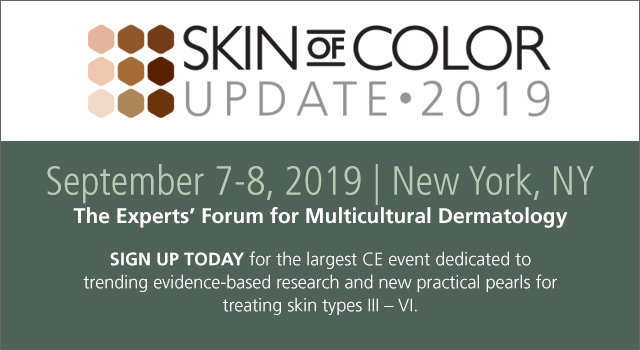During the 2018 Skin of Color Seminar Series (now the Skin of Color Update), Dr. Maritza Perez, one of the foremost leaders in skin of color dermatology, took attendees inside the world of the U.S. Hispanic population shedding light on the sociological diversity, cultural lifestyle hazards, and the healthcare disparities that increases their risk of deadly melanomas. Many Hispanics believe erroneously that they are less likely to get skin cancer, a dangerous preconception shared with many physicians who believe that this population is invulnerable to skin cancer, resulting in a delay in diagnosis and an unnecessary higher mortality rate.
Next Steps correspondent, Brianna Olamiju, reports back on Dr. Perez’s lecture and shares high- yield information all dermatologists should know.
The composition of individuals living in the United States is rapidly evolving. For example, in 2015, there were 57 million Latinos living in the United States. It is predicted that by 2060, 190 million Latinos will reside in the United States, making them the largest minority group in the country. It is imperative that dermatologists recognize how to identify and spread awareness about skin cancer within this population because Latinos are particularly at risk for delayed skin cancer detection and adverse health outcomes.
As Dr. Perez discussed, often times, research and education pertaining to skin cancer is focused on Caucasian populations due to increased incidence rates within patients of these populations. However, Dr. Perez shared personal experiences from her career as a dermatologist in which she has diagnosed numerous patients of Latino descent with skin cancer. She also conveyed the importance of spreading knowledge that Latinos are in fact susceptible to skin cancer and must take proper precautions against UV radiation.
In the past two decades, melanoma incidence rates in Latinos have increased by 20%. Although the overall incidence rate is lower in Latinos compared to Caucasians, the mortality rate is higher. Thicker tumors (>1 mm) and regional metastatic disease are observed more frequently in Latino individuals in comparison to Caucasians and Latino patients also report performing less skin self-examinations and less use of protective clothing for sun exposure.
There are many potential contributions to this disparity in health outcomes for Latino patients. Studies show that Latino patients are less likely to have healthcare insurance, making access to board certified dermatologists more challenging. In fact, 15% of Latinos living in the United States presently are uninsured. There are also delays for Latino patients in seeking treatment for new or changed skin lesions, since many may not recognize the signs and also the urgency of early diagnosis. Finally, despite being more likely to have a job that exposes them to the sun recurrently, patients of Latino descent are not frequently recruited for skin cancer screenings. It is important that they, too, are informed when these are held since early diagnosis is associated with increased survival rates.
As Dr. Perez highlighted, it is time for healthcare providers and policymakers to collaborate to help merge this healthcare disparity. We must dispel the misconception that Latino patients do not need sun protection because of their tendency to have greater baseline skin pigment. We must educate all patients to avoid tanning beds and direct sun contact in the middle of the day, and to wear proper skin and eye protection. Patients who present to dermatologists for skin checks must be evaluated from head to toe with a dermatoscope, with particular caution not to miss any areas. Dr. Perez also suggested teledermatology as a potential solution to bring dermatologic care to areas with lower access and high need. Ultimately, this could save countless lives.
Hu S, Parmet Y, Allen G, et al. Disparity in MelanomaA Trend Analysis of Melanoma Incidence and Stage at Diagnosis Among Whites, Hispanics, and Blacks in Florida. Arch Dermatol. 2009;145(12):1369–1374. doi:10.1001/archdermatol.2009.302
Rouhani P, Pinheiro PS, Sherman R, et al. Increasing Rates of Melanoma Among Nonwhites in Florida Compared With the United States. Arch Dermatol. 2010;146(7):741–746. doi:10.1001/archdermatol.2010.133
Pollitt, Ricardo A. et al. “The Expanding Melanoma Burden in California Hispanics: Importance of Socioeconomic Distribution, Histologic Subtype and Anatomic Location.” Cancer 117.1 (2011): 152–161. PMC. Web. 24 May 2018.


